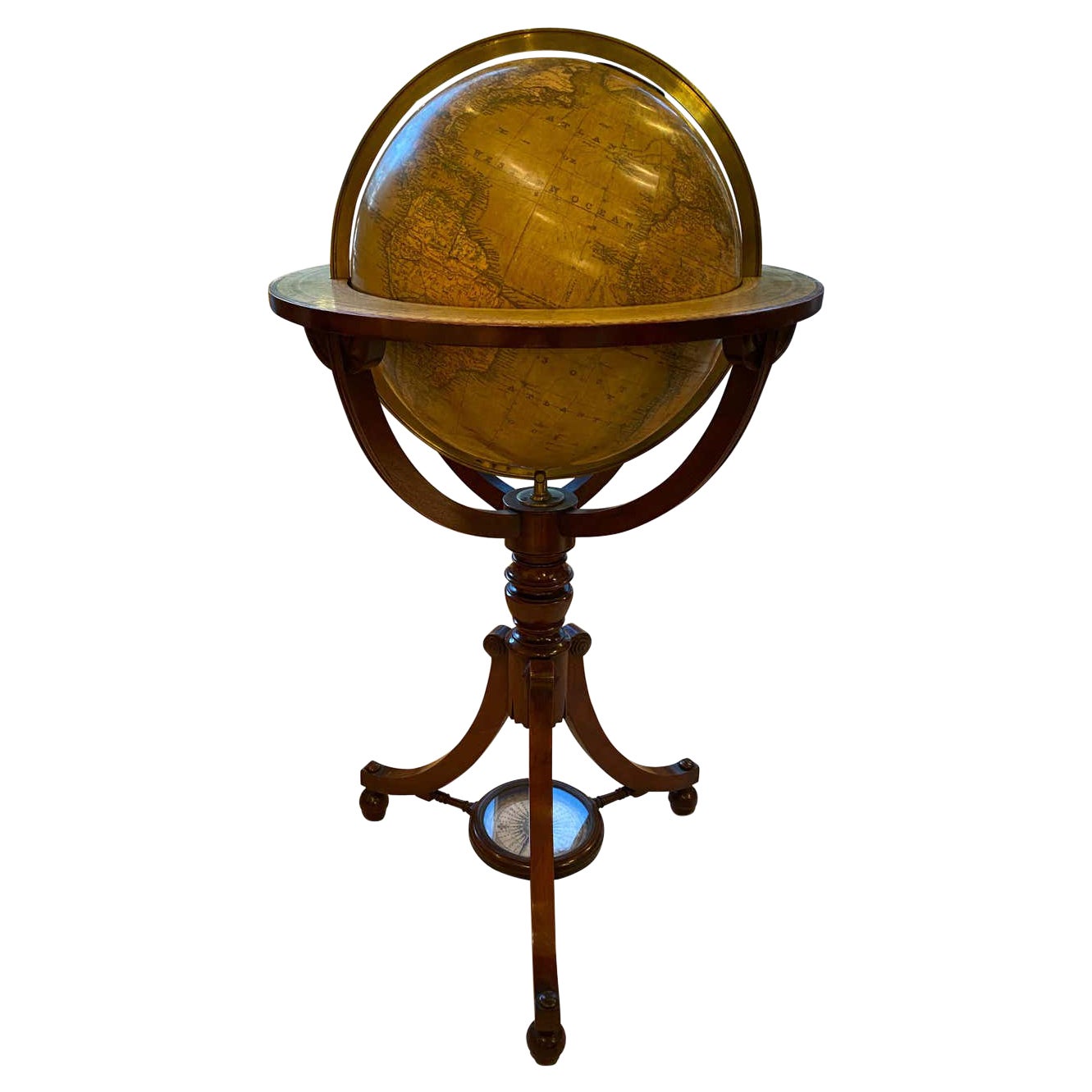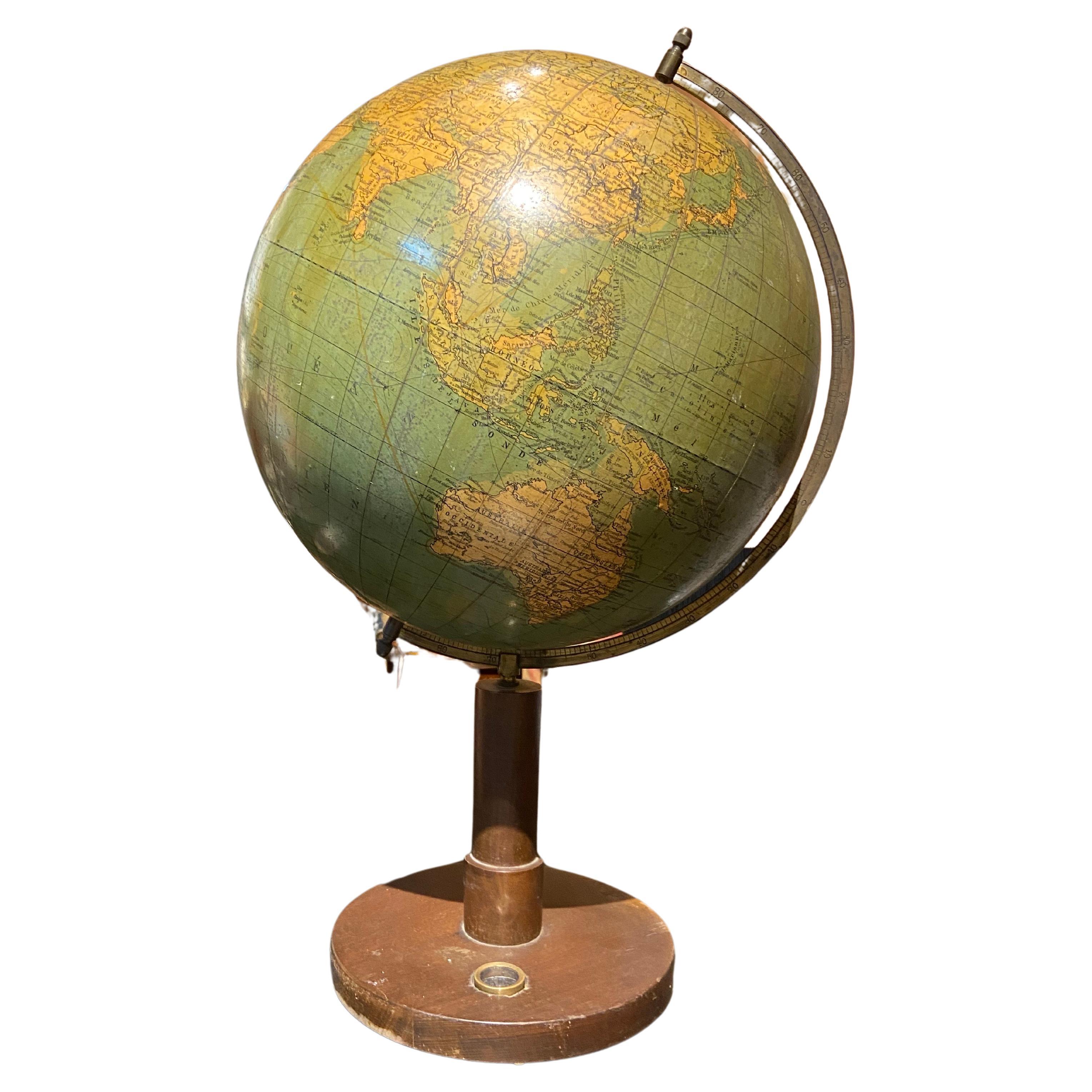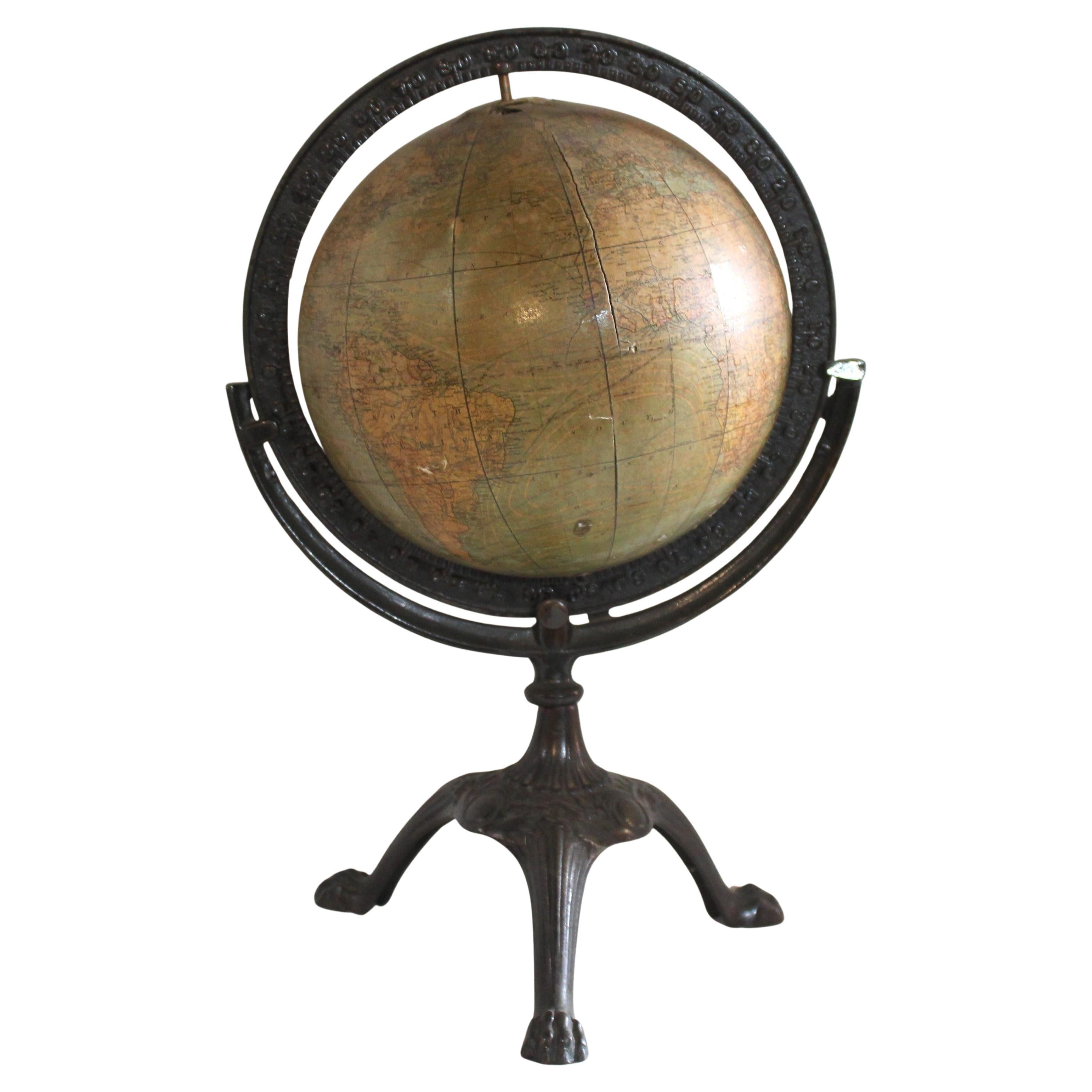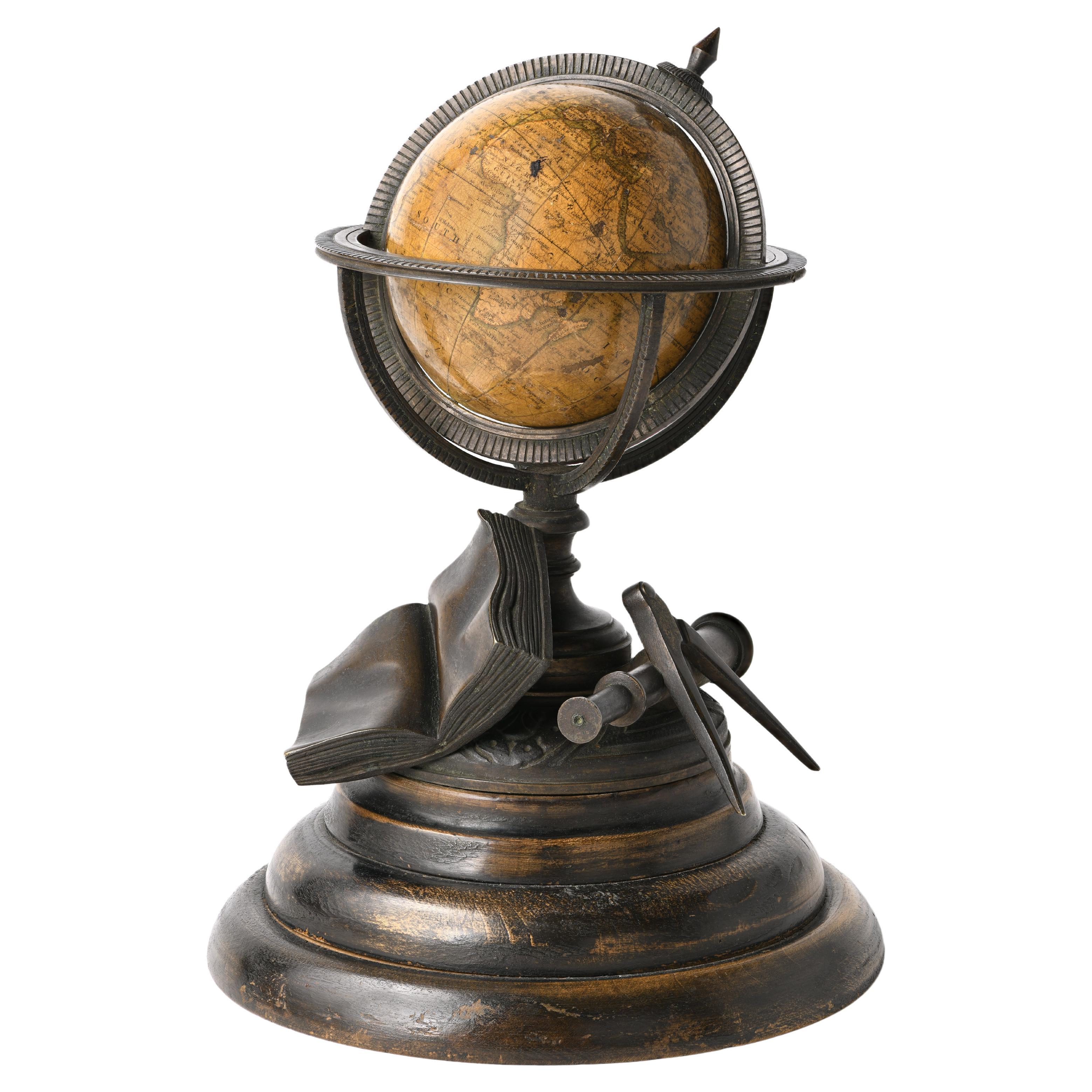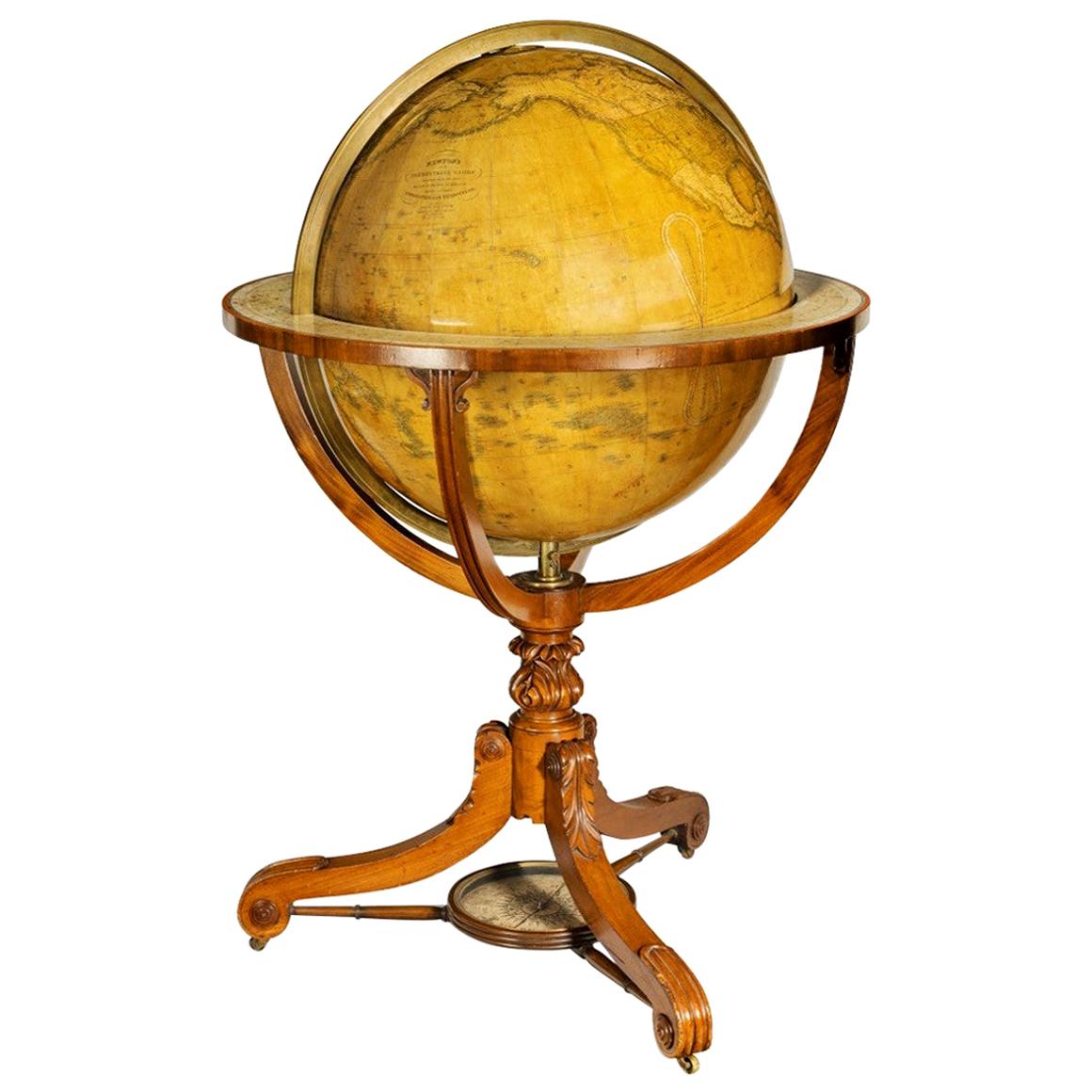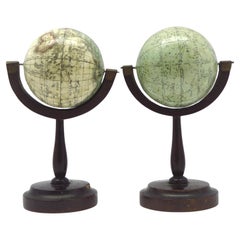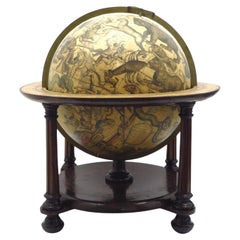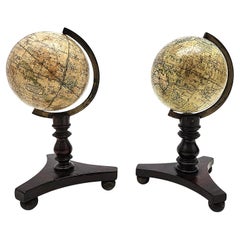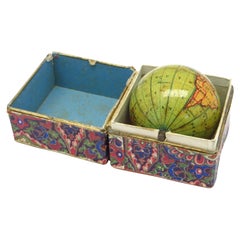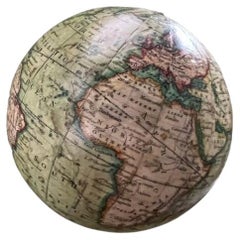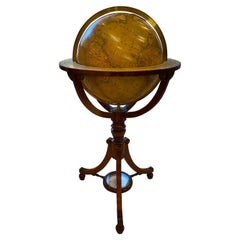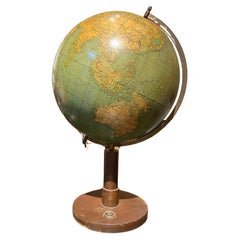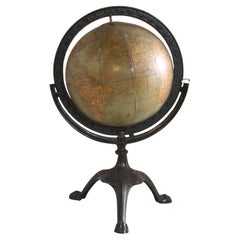Items Similar to An English POCKET GLOBE with dial for time zones
Video Loading
Want more images or videos?
Request additional images or videos from the seller
1 of 11
An English POCKET GLOBE with dial for time zones
$11,918.70
$14,898.3820% Off
£8,825.73
£11,032.1620% Off
€10,000
€12,50020% Off
CA$16,390
CA$20,487.5020% Off
A$18,229.89
A$22,787.3620% Off
CHF 9,541.13
CHF 11,926.4220% Off
MX$222,344.55
MX$277,930.6920% Off
NOK 119,887.82
NOK 149,859.7820% Off
SEK 112,769.98
SEK 140,962.4720% Off
DKK 76,133.08
DKK 95,166.3520% Off
About the Item
NEWTON & SON (fl.1840-61)
AN ENGLISH POCKET GLOBE WITH A DIAL FOR TIME ZONES, CIRCA 1835
A previously unrecorded stand for an early-19th-century English globe.
A 3-inch (7.6cm.) diameter terrestrial globe made up of twelve hand-colored engraved gores, cartouche in north Pacific NEWTON'S New & Improved TERRESTRIAL GLOBE.
Published by Newton & Son 66 Chancery Lane & 3. Fleet St, Temple Bar, the equatorial graduated in degrees, the Meridian of London ungraduated, the ecliptic graduated in days of the houses of the Zodiac with sigils, cartouche in the oceans with the tracks of Cook's 2nd and 3rd voyages, and Biscoe's antarctic voyage 1830-31, with various dates and some notes, the continents outlined in color and showing rivers, mountains, deserts, towns, cities and the Chinese wall, Alaska labeled Russian Territory, South Africa labeled CAFRERIA, the islands of New Zealand labeled in Maori Eahei Nomauwe and Tavai Poenamoo, Antarctica showing only the small portion of coastline for Enderby’s land.
Supported in an ungraduated, half-meridian arc, sitting atop a wooden stand with an inset compass, the front dial gives the time zones of various cities, with a rotating volvelle.
9 1/4 x 3 3/4 x 3 3/4 in.
(23.5 x 9.5 x 9.5 cm.)
- Creator:Newton and Son (Designer)
- Dimensions:Height: 9.25 in (23.5 cm)Width: 3.75 in (9.53 cm)Depth: 3.75 in (9.53 cm)
- Style:Other (Of the Period)
- Materials and Techniques:
- Place of Origin:
- Period:
- Date of Manufacture:1835
- Condition:Wear consistent with age and use. pocket globe sitting atop a wooden stand with inset compass, the front dial giving the time zones of various cities, with rotating volvelle.
- Seller Location:ZWIJNDRECHT, NL
- Reference Number:Seller: Jacob B. de Roo, owner since 2004 from Antiquariaat De Roo1stDibs: LU9419243432982
About the Seller
No Reviews Yet
Vetted Professional Seller
Every seller passes strict standards for authenticity and reliability
Established in 2004
1stDibs seller since 2023
- ShippingRetrieving quote...Shipping from: ZWIJNDRECHT, Netherlands
- Return Policy
Authenticity Guarantee
In the unlikely event there’s an issue with an item’s authenticity, contact us within 1 year for a full refund. DetailsMoney-Back Guarantee
If your item is not as described, is damaged in transit, or does not arrive, contact us within 7 days for a full refund. Details24-Hour Cancellation
You have a 24-hour grace period in which to reconsider your purchase, with no questions asked.Vetted Professional Sellers
Our world-class sellers must adhere to strict standards for service and quality, maintaining the integrity of our listings.Price-Match Guarantee
If you find that a seller listed the same item for a lower price elsewhere, we’ll match it.Trusted Global Delivery
Our best-in-class carrier network provides specialized shipping options worldwide, including custom delivery.More From This Seller
View AllA fine pair of miniature globes on stands
By Karl Muller
Located in ZWIJNDRECHT, NL
A rare pair of miniature terrestrial and celestial globes.
by K. Müller, 1822
Karlsruhe, Germany
Diameter globes: 7 cm. Total high: 14,5 cm.
Each with 12 hand-coloured engraved p...
Category
Antique Early 19th Century German International Style Globes
Materials
Hardwood, Paper
A beautiful Celestial Table Globe produced by Gerard & Leonard Valk
By Gerard and Leonard Valk
Located in ZWIJNDRECHT, NL
A magnificent and very rare early 18th century celestial table globe produced by Gerard and Leonard Valk. Established at the end of the previous ...
Category
Antique Early 18th Century Dutch Dutch Colonial Globes
Materials
Other
$190,699 Sale Price
20% Off
Free Shipping
Lovely pair of English miniature globes on carved wooden stands
By Newton and Son
Located in ZWIJNDRECHT, NL
“NEWTON’S NEW & IMPROVED TERRESTRIAL and CELESTIAL GLOBES".
PUBLISHED BY NEWTON & SON,
66 CHANCERY LANE, LONDON.”
No date but ca. 1820-1830.
Diameter globes 2.75 inches / Total heig...
Category
Antique 1820s British Victorian Globes
Materials
Wood
$17,639 Sale Price / set
20% Off
Free Shipping
Miniature pocket globe in colourful card box
By Michael Manning
Located in ZWIJNDRECHT, NL
Miniature terrestrial pocket globe. Model of the earth.
London, 1857 by J. Manning
diameter of 1,75 inches / 4,5 cm.
This lovely miniature terrestrial globe consists of twelve copper engraved, hand coloured gores over a wooden base. The gores are varnished. The colouring is both subtle and original. With a central pin contained in a colourful card box.
A little about miniature globes: The miniature or pocket globe was a British invention, introduced to the world by Joseph Moxon in 1673 when he produced a 3-inch globe. To own a pocket globe is to have the whole world in miniature. Pocket globes were never to be taken very seriously – they never served any practical purpose; their size makes accurate calculations impossible, and they tend to lack the rings and dials for most common manipulations. No, they were seen more as a status symbol, or a lovely decorative artistic artefact to reside on a gentleman’s desk or small table. There is a school of thought that some of the cheaper pocket globes may have aided children’s education. Today, they reflect a lost and never-to-be-forgotten age of exploration...
Category
Antique 19th Century British Early Victorian Globes
Materials
Hardwood, Paper
A pair of extremely rare Valk table globes
By Gerard and Leonard Valk
Located in ZWIJNDRECHT, NL
Title on the globes:
VALK, Gerard and Leonard. [Terrestrial globe:] Cosmotheore, caelesti nostro globo, par, et plane novus, hic terrestris ut existeret, certo scias, errore veterum ...
Category
Antique 18th Century Dutch Dutch Colonial Globes
Materials
Other
A decorative pair of rare table globes in a fine condition.
By Johann Gabriel Doppelmayr
Located in ZWIJNDRECHT, NL
These pair of globes, dated 1730, are original and in fine condition.
Title:
Globus terrestris novus Loca Terrae insigniora sec. praestant Astron. et Geogr. observationes sistens op...
Category
Antique Early 18th Century German Baroque Globes
Materials
Other
You May Also Like
Newton and Son Pocket Globe and Case
By Newton and Son
Located in Spencertown, NY
The terrestrial globe is 3 inches in diameter contained within a turned mahogany box with cover. The seas in light green and land masses in darker green.
Dimension of Globe 3" Diame...
Category
Antique Mid-19th Century English Victorian Globes
Materials
Fruitwood, Paper
19th Century English Globe by Renowned Cartographers John Newton and Son
By Newton and Son
Located in Southall, GB
An extremely rare and important 21 inch English globe by renowned cartographers John Newton and Son, one of the most important globe makers of early 19th century England. Representin...
Category
Antique 19th Century English Scientific Instruments
Materials
Hardwood
$53,996 Sale Price
20% Off
European Vintage Earth Globe on Stand with Compass
Located in Sofia, BG
Vintage handmade world globe standing on a base with small compass in the bottom. The piece is in fare condition with no restaurations ever made.
France, circa 1950
Category
Mid-20th Century French Maps
Materials
Plastic, Paper
W. & A.K. Johnston 8" Globe
Located in Brooklyn, NY
This antique globe was made by W. & A.K. Johnston, a Scottish firm founded in 1825. Set inside a cast iron stand with claw feet. The globe can spin as well as revolve around using th...
Category
Early 20th Century Globes
Materials
Cast Stone
Miniature Terrestrial Globe Newton & Son London, Post 1833, Ante 1858
By Newton and Son
Located in Milano, IT
Miniature Terrestrial Globe
Newton & Son
London, post 1833, ante 1858
Paper, papier-mâché, bronze and wood
It measures: sphere diameter 2.95 in (7.6 cm); diameter of the wooden base 6.02 in (15.3 cm); height 8.36 in (21.24 cm).
Weight: 2,067 lb.
State of conservation: the globe still bears its original paint, but has various small gaps, abrasions and stains on the surface.
The globe is hinged with two pins at the meridian circle, which is in turn inserted perpendicular to the horizon circle; this is supported by four semi-arches connected at the bottom by a small goblet-shaped foot, resting on a wooden bell-shaped base.
Apart from the wooden base, the entire support structure is made of bronze; on the foot there are the scale reproductions of a compass, a telescope and an open book.
The sphere is made of papier-mâché and is covered with twelve printed paper gores.
In the North Pacific Ocean the globe bears a cartouche with the inscription (about 30% of the writing is illegible, but the missing parts can be easily integrated based on the rest):
NEWTON’S
New & Improved
TERRESTRIAL
Globe
Published by Newton & Son
66 Chancery Lane
LONDON
On the globe, much of central Africa is empty and the great lakes Tanganyika and Victoria are not marked (Europeans would begin to explore the area after 1858). Canada is called "British Territory" and Alaska "Russian Territory" (it would become part of the United States in 1867). Australia already bears its modern name (until 1829 it had been called New Holland) and its coasts are completely designed; Tasmania is listed as an island (Matthew Flinders circumnavigated it in 1798). The routes of Cook's various voyages are plotted; both the route followed by Biscoe in 1831 and the "Land of Enderby" which he discovered on the coast of Antarctica, south of Africa, are marked.
Bibliography
P. Van der Krogt, Old Globes...
Category
Antique 1840s English Early Victorian Maps
Materials
Bronze
Large and Extremely Rare Terrestrial Globe by Newton
By Newton Globes - Planer & Newton
Located in Lymington, Hampshire
A large and extremely rare 24-inch terrestrial globe by Newton
Our most magnificent and rare globes were a pair of 24-inch Newton globes.
These too were updated in 1852 (terre...
Category
Antique Mid-19th Century English Globes
Materials
Mahogany
More Ways To Browse
Antique South Africa
Small Antique Globes
Used Furniture Newton
Antique Globe Bar
New Zealand Maori
Antique Maori
Zodiac Bar
Pocket Globe
Weber Costello
Pearsall Globe
Rand Mcnally Terrestrial Globe
Adrian Pearsall Globe
Arthur Krause
Denoyer Geppert Globe
Repogle Globe
Denoyer Geppert Chalk Globe
Globus Table
Gustav Brueckmann

